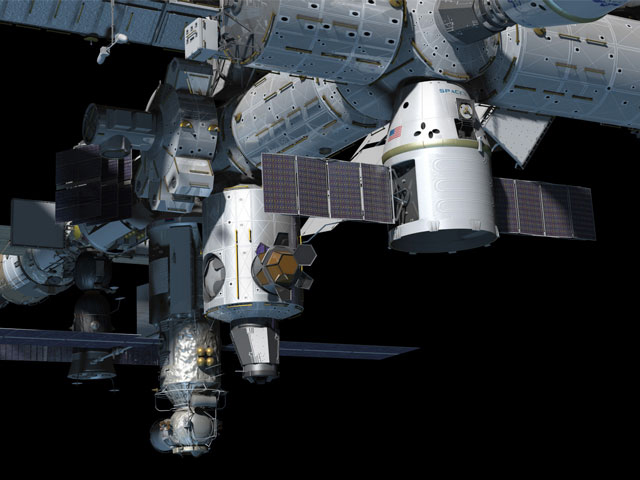Space Station Crew Excited for 1st Private Spaceship Visit

The three astronauts living on the International Space Station are ready to usher in a new era at their orbiting home: the first arrival of a privately built spacecraft.
The Hawthorne, Calif.-based commercial spaceflight company Space Exploration Technologies, or SpaceX, is preparing to launch its Dragon capsule toward the station May 7 on an unmanned mission to deliver supplies and demonstrate its own abilities. The flight is the Dragon capsule's maiden voyage for SpaceX under a NASA program aimed at buying cargo delivery services from private companies, now that the agency's space shuttles are retired.
The three astronauts on the space station are vital to the SpaceX capsule's safe arrival; the job falls to them to use the space station's robotic arm to grab the craft as it approaches (Dragon does not carry the tools that would allow it to dock itself).
"It feels very good to be part of that and I look forward to it very much," European Space Agency astronaut Andre Kuipers, who hails from the Netherlands, told the Associated Press Tuesday (May 1) during an interview broadcast on NASA TV. "This is the start of a real new era and I expect there's a lot more to come."
Kuipers and his crewmate Don Pettit of NASA will be the ones manning the robotic arm, called the Canadarm. The two spacemen have been using software, as well as practice runs with the real arm, to get ready for the event. [Photos: Dragon, SpaceX's Private Spaceship]
"We were practicing a bit this morning," Pettit said. "We do it over and over and over again. We are getting prepared for our visitor next week."
Dragon is slated to launch next week aboard a SpaceX Falcon 9 booster rocket from Cape Canaveral Air Force Station in Florida. It will spend about three days catching up to the space laboratory in orbit and undergoing checkouts, and then will be pulled in to make a docking with the station. The capsule will carry food, clothing, supplies and scientific equipment for the astronauts, though none of it is critical, since this mission is officially a test flight.
Get the Space.com Newsletter
Breaking space news, the latest updates on rocket launches, skywatching events and more!
However, NASA officials are hoping things go smoothly to pave the way for a more regular delivery service by SpaceX, as well as another NASA-contracted company, Orbital Sciences Corp. of Dulles, Va. Orbital is due to fly its Cygnus spacecraft on a first demonstration flight later this year.
Overall, NASA has contracted SpaceX to fly 12 more cargo delivery flights for a total of $1.6 billion. Orbital has received an order for eight flights for $1.9 billion.
Pettit compared this new commercial-government partnership to what happened with forts in the Old West. While the U.S. government sponsored the forts and defined the mission, commercial outfitters ran the wagon trains that supplied the forts.
"Now government-run agencies like NASA can concentrate on the frontier aspect of being in space," Pettit said. "They can define what we're doing and then we can have the commercial entities supply us the gods and services we need in order to do the mission."
You can follow SPACE.com assistant managing editor Clara Moskowitz on Twitter @ClaraMoskowitz. Follow SPACE.com for the latest in space science and exploration news on Twitter @Spacedotcom and on Facebook.
Join our Space Forums to keep talking space on the latest missions, night sky and more! And if you have a news tip, correction or comment, let us know at: community@space.com.

Clara Moskowitz is a science and space writer who joined the Space.com team in 2008 and served as Assistant Managing Editor from 2011 to 2013. Clara has a bachelor's degree in astronomy and physics from Wesleyan University, and a graduate certificate in science writing from the University of California, Santa Cruz. She covers everything from astronomy to human spaceflight and once aced a NASTAR suborbital spaceflight training program for space missions. Clara is currently Associate Editor of Scientific American. To see her latest project is, follow Clara on Twitter.









